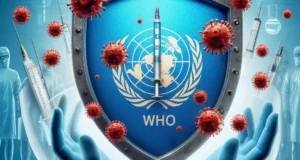Imagine a hidden intersection deep in the jungles of Central Africa—a crossroad not paved with asphalt, but with blood, biology, and colonial footprints. This is no ordinary junction. It’s the “Viral Crossroads”, where fate, science, and species converged in a moment that would silently ignite one of the most devastating pandemics of our time. Here begins the story that seeks to answer the elusive question: AIDS, where did it come from?

The Viral Crossroads Hypothesis proposes that HIV didn’t just appear; it emerged at a unique historical moment when human ambition brushed dangerously against nature’s boundaries. Picture the scene: in the early 20th century, European colonial forces were expanding deep into Africa’s heart. . On the other side of the road were primates—chimpanzees, specifically—that carried a quiet passenger: SIV, the simian immunodeficiency virus.
These primates were hunted for bushmeat. Their blood, rich with ancient viral codes, often mingled with human blood through cuts and injuries—what scientists now call a “spillover event”. This was no ordinary contact; it was the first handshake between species that would later manifest as HIV. But that handshake wasn’t enough on its own. The question of AIDS—where did it come from— doesn’t end with a monkey bite.

At the same crossroad stood colonial medicine. In an era before sterilization was standard, reusable needles became silent collaborators in viral amplification. Used on hundreds during vaccination campaigns, treatments, and even experiments, these tools acted like viral teleporters—transferring HIV from one bloodstream to another before anyone even knew it existed.
It’s not just a theory of origin—it’s a tapestry of context. The Viral Crossroads Hypothesis draws our attention to the broader ecology of disease. The virus didn’t leap out of nowhere. It crossed over at a moment when human systems—social, medical, and colonial—were most vulnerable. It was not a single event but a series of converging paths: wildlife exploitation, medical negligence, urban migration, and silence.
And yet, for decades, the world kept asking: AIDS—where did it come from? The truth lay buried in this intersection. By the time the virus reached Kinshasa, one of the first cities with railroads and dense populations, it had found a superhighway. From there, HIV quietly traveled—on trains, in blood, through lovers—spreading across borders long before it was named.
This hypothesis also reminds us that pandemics are not born in a vacuum. They are forged at junctions where ecological disruption meets human error. The Viral Crossroads wasn’t just a place in space—it was a moment in time when humanity unknowingly cracked open nature’s viral vault.
The question “AIDS where did it come from” now finds a haunting yet enlightening answer: it came from a crossroad—a viral intersection that no map shows but history cannot ignore. Understanding this moment does not just satisfy curiosity; it offers a warning.
So the next time we ask “AIDS where did it come from?”, we should remember that the answer isn’t just in the virus—it’s in the story of how human hands, driven by dominance and urgency, collided with nature’s deepest secrets. At the Viral Crossroads, HIV found its gateway. The world would never be the same.




